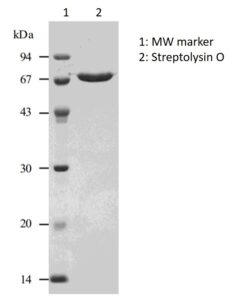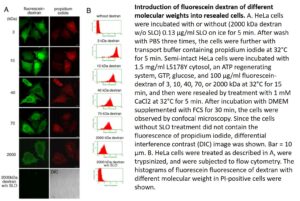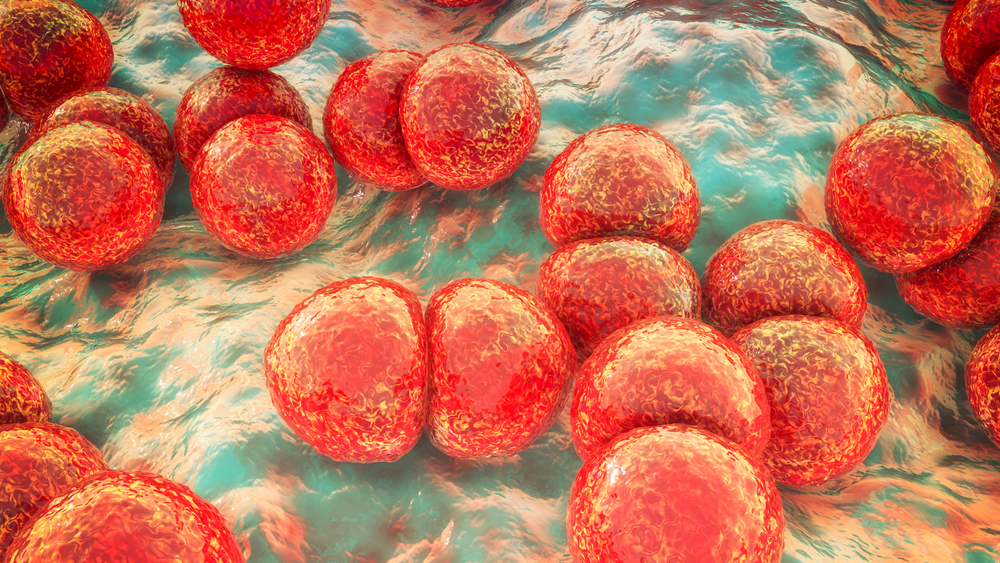
SDS-PAGE: Purified streptolysin O (SLO) analysed by SDS-PAGE.

Streptolysin O (Hemolytic Streptococcus), Active
$580.04 excl. VAT
Recombinant Streptolysin O, highly purified from E. coli over-expressing SLO of Group C hemolytic Streptococci. Reagent for membrane pore formation to introduce small-to-macromolecules into living cells.
STREPTOLYSIN O (HEMOLYTIC STREPTOCOCCUS), ACTIVE
Recombinant Streptolysin O, highly purified from E. coli over-expressing SLO of Group C hemolytic Streptococci (6xHis-tagged to the signal peptide removed N-terminal of SLO). Functional in membrane pore formation to introduce molecules into living animal cells.
PRODUCT DETAILS – STREPTOLYSIN O (HEMOLYTIC STREPTOCOCCUS), ACTIVE
- Recombinant Streptolysin O, active toxin.
- Purified from E. coli to greater than 98% (by SDS-PAGE)
- Presented in PBS (-), 1 mM DTT, 50% glycerol, sterilized by filtration. No additive nor carrier protein.
BACKGROUND
Group A Streptococci (GAS) are important human pathogens and millions of children each year develop GAS pharyngitis. Although throat infection is typically benign, it can be complicated by the development of acute and chronic rheumatic heart disease. Invasive GAS infection occurs less frequently than pharyngitis but causes significantly more morbidity (Stevens, 1996).
GAS produce two hemolysins (hemolytic exotoxins) that may contribute to pathogenesis. These are streptolysin O (SLO; slo), which is oxygen-labile, and streptolysin S (SLS; sagA), which is oxygen-stable. SLO is part of the thiol-activated cytolysin family. It is hemolytically active only in a reversibly reduced state. Partly as a function of its size it is antigenic, so its antibody antistreptolysin O can be detected in an antistreptolysin O titre. SLO mainly affects the breaking of red blood cells (hemolysis) and is mostly produced by the GAS and Streptococcus dysgalactiae. SLO interacts with cholesterol in the membrane of eukaryotic cells (mainly red and white blood cells, macrophages, and platelets) and usually results in β-hemolysis under the surface of blood agar. It targets myocardial cells, epithelial cells, platelets, and neutrophils and is thought to prevent the host immune system from clearing infection. The cytotoxic effects of SLO may also protect GAS from phagocytic killing and enhance bacterial virulence, particularly of strains that may be relatively deficient in hyaluronic acid capsule (Sierig et al., 2003).
REFERENCES
- Sierig G, Cywes C, Wessels MR, Ashbaugh CD. Cytotoxic effects of streptolysin o and streptolysin s enhance the virulence of poorly encapsulated group a streptococci. Infect Immun. 2003 Jan;71(1):446-55.
- Stevens DL. Invasive group A streptococcal disease. Infect Agents Dis. 1996 Jun;5(3):157-66.

